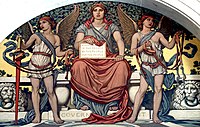
Photo from wikipedia
Through an overview of the decade 2008 to 2017, and looking comparatively across four northern European cities, this paper reflects on the changing nature of public space during these austerity… Click to show full abstract
Through an overview of the decade 2008 to 2017, and looking comparatively across four northern European cities, this paper reflects on the changing nature of public space during these austerity years and on the processes of shaping public spaces. The paper draws from the experiences of London, Copenhagen, Malmo and Oslo to explore processes of the design, development, use and management of public spaces during this period. The evidence suggests that we have witnessed a period of significant innovation, side by side with major challenges to the collective approach to public spaces. This has led to distinct forms of public spaces that for good or ill have multiplied as a result of the trends discussed in the paper, spaces of; expectation; the private/public sphere; spectacle; respite; infrastructure; diversion; income generation; security; the ephemeral city; community control; occupation; disadvantage; and decline. Episodes of changing practice are set out in the paper and cumulatively reveal distinct and significant changes during the austerity era, although not necessarily in the manner that might have been expected. Instead, in these four cities, the impact of austerity seems to have been eclipsed by other evolving and competing public policy goals, and by the evolving range of public space types.
Journal Title: URBAN DESIGN International
Year Published: 2019
Link to full text (if available)
Share on Social Media: Sign Up to like & get
recommendations!